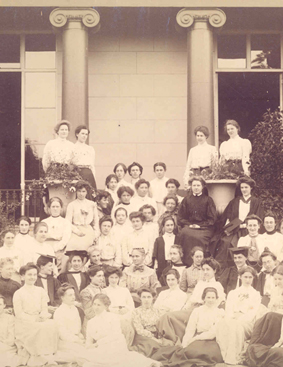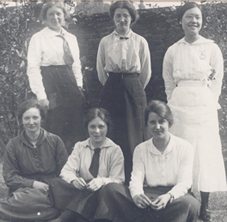| Four Colleges | |||||
| Women at Queen Mary Online: a virtual exhibition | |||||
 |
|||||
| In this section: | Westfield College | |||||
|
> The London Hospital Medical College > St Bartholomew's Hospital Medical College > Today's Queen Mary, University of London
|
||||||
Westfield College was founded in 1882 as a college for the higher education of women. It was amongst a select group of higher education institutions established for women in the late nineteenth century, and offered new opportunities for women to reside and study in London. The College was founded through the efforts of women including Ann Dudin Brown, Constance Maynard, Caroline Cavendish and Mary Petrie. These women and others shared a vision of promoting 'Higher Christian Education for Women', and they agreed to the founding of a residential women's college in London, which would be modelled on the women's colleges that had been established in Oxford and Cambridge. The site for the college was located in Hampstead, and Dudin Brown provided £10,000 for its establishment. The name Westfield may have come from the name of the buildings which first housed the College: Westfield Villas in Maresfield Gardens, Hampstead. However, Constance Maynard tells a more colourful story in her 1927 reflections on "The Inception of Westfield College". The College Council had originally chosen the name St Hilda's, but after the gate and letterhead had been emblazoned with that name, a small local school of the same name objected and threatened legal action. Maynard recalls how she consulted a colleague, Miss Metcalfe, who, looking out the window, said: "The front aspect is west - Westleigh sounds a little too like John Wesley, - what do you say to 'Westfield'?" The name was only meant to be provisional, but it remained, with no moves to change it thereafter. When it was founded in 1882, the College was officially an examining body, and in 1898 was recognised by University of London as a teaching body. In 1902, it was given temporary admission as a 'school' in arts. In 1905, a science department was opened, concentrating on botanical science, which was led by Ellen Delf-Smith.
From 1903, non-resident students were admitted and this led to a relaxing of regulations concerning student activities. In 1919, the trust deed of the College was changed so that it no longer insisted all members of the College Council were members of the Church of England. With this alteration in place the University of London approved Westfield College as a full member of the reconstituted university, and agreed to allocate an annual grant. Four members of staff were granted the title University Reader, and in 1925 Caroline Skeel was given the title University Professor of History. By 1929, the College was granted the full privileges of a School of the University of London, and in 1932 it was granted its Royal Charter. In 1939, Westfield College had to evacuate to Oxford during WWII, and Principal Mary Stocks ensured that college life continued as normal as possible. Learn more about Westfield's evacuation to Oxford here. In 1961, students were admitted to study science in a new purpose-built facility, and the department was later expanded to include computer science in 1971. In 1963, the College agreed to proposals 'that men students shall be admitted to the College', which had been debated over a number of years, and the Charter was amended appropriately in 1964. As a result, in 1965, over 100 male students were admitted for the first time. In the same year, a purpose-built science facility was opened.
From its inception, the College was supported and populated by staff and students who became significant figures in their areas of expertise and research. Westfield College represents a leading example in the history of higher education for women. To learn more about Westfield College, Janet Sondheimer's book Castle Adamant in Hampstead: A history of Westfield College provides a well-researched history of the College from 1882-1982. The College Archives hold an extensive collection of material relating to Westfield College, its founding, history, staff and students, from its opening in 1882 to its merger with Queen Mary College in 1989. |
| << previous | Explore Four Colleges |
|



